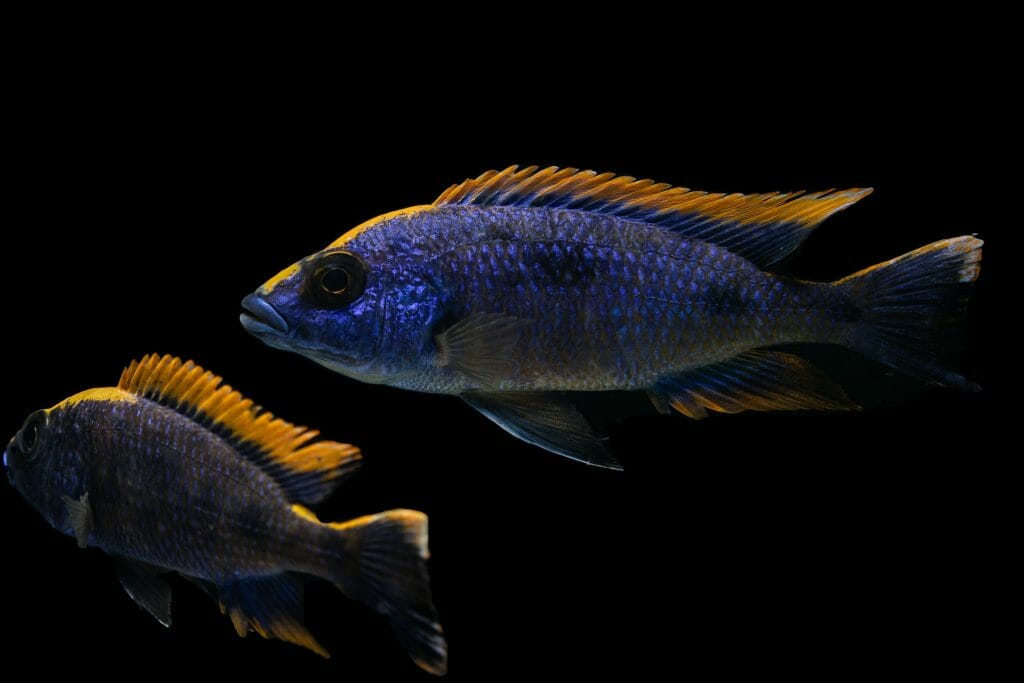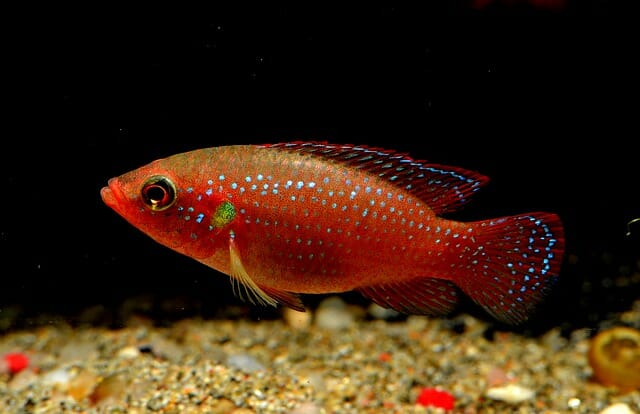When Do Peacock Cichlids Get Their Color?

The color of a peacock cichlid is determined by the particular strain of cichlid it is. There are many different strains of peacock cichlids, and each has a different color. Some strains have light colors, and some have dark colors. The color of a peacock cichlid is usually determined when the fish are young but can also change as the fish get older.
The color of a peacock cichlid will change over time as they mature. As a result, they become more colorful as they grow older, and their colors may vary depending on where they are from.
Table of Contents
How Do Peacock Cichlids Get Their Color?
When peacock cichlids get their color, it is typically in two stages. The first stage is when the fish start to get a pinkish hue on their body and fins. This happens around the age of three to four months. The second stage is when they turn a bright blue or green. This can happen anywhere from six to eight months after the first stage.
When Do Baby Cichlids Get Their Color?
There is no definitive answer to this question as it will vary depending on the particular species of peacock cichlid. However, peacock cichlids generally tend to become brightly colored as they mature, though this can vary depending on the specific species. Some examples of colors that are commonly seen in peacock cichlids include blue, green, yellow, orange, and red.
Can Peacock Cichlids Get Their Color Easily?
Many cichlids will become colorful within minutes of being introduced to a new healthy environment or tank. The process starts with the male cichlid changing his coloring from a dull green or brown to bright red, yellow, or blue. This change is due to an increase in melanin production (a substance that gives fish their color).
Why Is My Cichlid Changing Colors?
There are a few reasons why your cichlid might be changing colors. Maybe it’s getting colder, and its body shows signs of wear, or perhaps you’re just providing a better environment, and its natural color is starting to change. The most common reason for a cichlid’s color change is age. As they get older, their skin starts to thin and may lose color. This happens because the cells that produce pigment begin to die off, resulting from environmental factors (like sunlight exposure) or the fish’s metabolism. Another possibility is that your cichlid is getting healthier thanks to better water conditions and a more varied diet. In nature, cichlids live in areas with plenty of different types of food, which helps them develop a more colorful appearance.
How to Help Peacock Cichlids Get Vibrant Colors?
The peacock cichlid is a beautiful fish, but it can be challenging to get them to have vibrant colors. Some tips on how to help your cichlids get their color are as follows:
- Feed them a varied diet that includes plenty of colorful vegetables and fruits.
- Give them plenty of swimming space and keep their tank clean.
- Try different lighting fixtures and see what works best for your tank.
- Add different types of water conditions, such as soft or hard, acidic or alkaline, warm or cold, etc.
Does Substrate Affect Peacock Cichlid’s Colors?
There is some debate about whether substrate affects cichlid colors, but most experts agree that it does to some degree. The substrate or soil used affects how much light the cichlid can absorb and thus its coloration. Some cichlids prefer dark substrates while others prefer light substrates, so it’s essential to provide a variety for them to choose from. Additionally, some cichlids will change their colors depending on their mood or environment. For example, if a cichlid feels stressed or threatened, it may change its coloration to intimidate its opponents.
What to Consider for Peacock Cichlids to Change Color?
A few factors can influence the onset of peacock cichlid coloration. These include genetic factors, temperature, and water quality. Genetic factors are undoubtedly important in determining peacock cichlid coloration. For example, some fish may change color as early as three to four months after hatching due to specific gene expression that affects pigmentation.
Temperature also has a significant impact on peacock cichlid coloration. Warmer water temperatures tend to cause more yellow and green colors, while cooler temperatures cause more blue and black colors. Finally, water quality can affect peacock cichlid coloration too. Poor water quality will often result in lower levels of dissolved oxygen, leading to the development of green or brown algae.
Frequently Asked Questions
Are There Differences With Peacock Cichlids Male and Female Colors?
There is a lot of debate about peacock cichlids and their color. Many people believe that the male peacock cichlid will have a more vibrant color than the female, but this is not always the case. Most female peacock cichlids will have a much brighter color than their male counterparts. This color difference is due to several factors, including genetics, diet, and environment.
When Do Flavescent Peacock Cichlids Get Their Color?
The color of peacock cichlids can vary quite a bit depending on the particular fish. Generally, the fish will start to change colors around 6-8 weeks after birth. Some variations include the fish changing from a light brown, tan, or yellow to a bright blue, green, or purple. It is important to remember that these changes are not always uniform and can take some time for all of the fish in a group to develop their new coloration.
When Do Red Jewel Cichlids Get Their Color?
When red jewel cichlids get their color, it can be unpredictable. Generally, they will turn a rich red color when they are about two years old. However, some individuals can take longer to turn the paint, and some may not work. If you are interested in acquiring a red jewel cichlid, it is best to wait until they have reached this age and are in good health.
